In March 2019, I flew to the Algarve with the goal of herping Portugal. I went from Olhão to Carrapateira, spotting reptiles and trying food and drink along the way.
Last updated on December 18th, 2022 at 01:16 pm
Portugal is an amazing place for a number of reasons, not least the incredible scenery. Warm weather, great seafood, and the Portuguese people themselves make the Algarve a popular spot for northern European tourists. This is an existential threat to the region’s wildlife, given the amount of property development it entails, but I was pleasantly surprised by the amount of natural areas and parks that have been protected or left untouched, save a few trails for hikers.
From a biologist’s point of view, Portugal and much of southern Iberia are of interest because they are of typical Mediterranean climate and habitat. Due to global air circulation patterns and its latitude, the Mediterranean basin is cool during the winter, then hot and fairly arid during the summer. This not-quite-northern, not-quite-subtropical climate is reflected in the mix of animal species found there. In the Algarve, for example, you can spot a Pigeon, a Flamingo, a Solifugid and a Grass Snake on the same day.
Why is Portugal a great place for herping?
Mediterranean regions tend to have an abundance of rocky areas where reptiles can hide, making them ideal for snakes and even fairly large diurnal lizards. These rocky areas are coupled with a sclerophyllous vegetation type, which is mostly evergreen shrubs and perfect for Chameleons to occupy, or Lacertids to run to for cover. The combination of these features with their geography has led to the southern Mediterranean regions of the Iberian Peninsular, Greece and Cyprus being home to the greatest reptile species richness in Europe.
As we look at the reptiles I encountered in the Algarve, I’m going to give you some information on them and everything else that makes herping Portugal so fascinating.
The Common Chameleon (Chameleo chamaeleon)
This species is one of only two members of the Chameleon family present in Europe. The other is the African Chameleon (Chamaeleo africanus), which lives in the Peloponnese, but is probably introduced.
The Common Chameleon fascinates me as it is what I would call a peripheral species in Europe – i.e. a species that is living at the northernmost limit of its family’s distribution area. Any further north and the climate is too continental for Chameleons, but this species has crept up to the very edge of suitable Chamaeleonidae habitat, probably because it is able to tolerate ever-so-slightly cooler temperatures than its African and Middle Eastern relatives.
On practically every herping trip report from Portugal you can see photos of Chameleons, but I was still eager to find some for myself to take a closer look at some of their unique adaptations. Fortunately, I found several around Faro within an hour and a half of landing.
fffghghjjhjkjkj
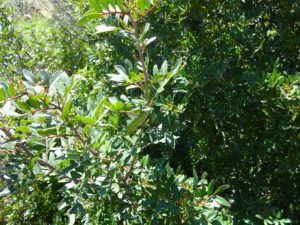
They were hard to see, but they were there! If you want to find Chameleons, make sure you are in an area of ideal habitat and vegetation type – and preferably with previous sightings recorded. Given how small it is, I probably spotted the one in the centre of this photo by luck more than anything else.
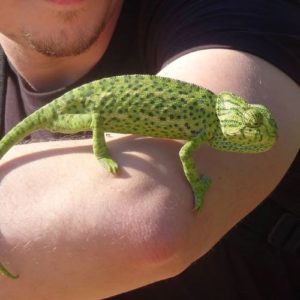
The best way to handle Chameleons is to put your hand in their path and let them walk over you. Avoiding actually grabbing them or picking them up stops them from getting stressed. If their colour darkens, it generally means they’re getting annoyed and have had enough of your company.
What makes Chameleons so unique?
When discussing this family of lizards your attention is always drawn to their three most obvious morphological adaptations: their sticky, projectile tongues, independently moving eyes and colour-changing skin. These are all fascinating, but Chameleons have other, equally fascinating adaptations that are often overlooked. For example, take a look at their feet – where have you seen ones like that before? On a Koala of course! The Koala and the Chameleon have incredibly similar feet thanks to convergent evolution.
In this case, the two species occupy a similar ecological niche, in the sense that they both climb along branches at a slow-to-medium pace and need to grip them effectively. This has led to them developing a convergent morphology to their anterior limbs and digits. In a nutshell, a Chameleon’s feet and a Koala’s front paws each possess five digits, with two opposed to the rest and forming a pincer-like grip. This shared foot morphology is an example of what is called a homoplastic trait.
dfgdfgffg

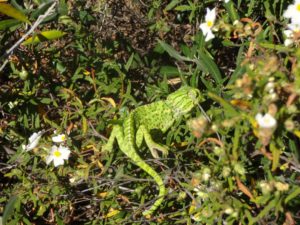
The similarity between the feet/paws of these two species is evident, despite the huge phylogenetic distance between them.
What other adaptations do Chameleons have?
Chameleons have more evolutionary tricks up their sleeve. Their bodies are laterally compressed, resulting in a high but slim profile and limbs that are placed closer to the centre of their body than in most lizards. This means that the central axis (and centre of gravity) of a Chameleon’s body is aligned directly above the branch it is walking on – improving balance and greatly reducing energy expenditure when on the move.
Last but not least, they have a prehensile tail which acts as a safety line if they fall when moving between two branches. This is of course another example of a homoplastic trait, with many arboreal animals like Spider Monkeys, Pangolins and the Solomon Island Skink (Corucia zebrata) sharing the feature.
Despite all these adaptations, this species doesn’t appear to occur at a high density in the Algarve and care should be taken if you handle one. Bare in mind that according to some authors, up to 40% of females die from the from the stress of egg production – so they are best left alone in late summer and autumn when they are gravid.
ffgfghghjh
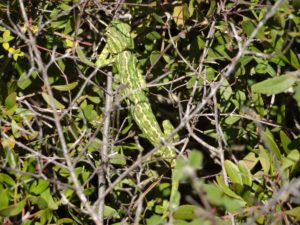
The chameleon in the top photo is demonstrating just how slim these animals look from above, due to their laterally compressed bodies. The specimen in the bottom photo is using its tail to help it safely climb down a bush. For some reason, all of the Chameleons I found that day were extremely active – making for good observation but difficult photography!
The Amphisbaenian: Blanus cinereus, Blanus mariae or Blanus vandelli?
Another oddball creature with a plethora of unusual adaptations is the little Amphisbaenian, or Worm Lizard that I found. Amphisbaenians in the Iberian Peninsular belong to the Blanidae family – meaning they are legless, unlike the New World Bipedidae, but in keeping with the other families. There’s been some confusion over which Blanidae species occurs in the Algarve, so I’m going to try to sum it up as succintly as possible (although I might not get the years things happened right).
Blanus cinereus occurs accross the Iberian Peninsular, but in 2009 two scientists determined that there was actually a separate, cryptic species occurring alongside B. cinereus. They described this cryptic species as B. mariae. Then, in 2017, two other scientists found that yes there are two species of Amphisbaenian in the Iberian Peninsular, but the newly described B. mariae was actually B. cinereus all along!
These two authors studied specimens and genetic samples from the region, then described and named the other species (the cryptic one) as B. vandelli. So, if you find a Worm Lizard in the Algarve or south-western Spain, it probably is the recently described Blanus vandelli – though it’s hard to tell without thorough examination of the specimen (something I didn’t do!).

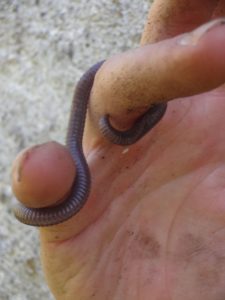
The animal in the second photo is poking me with its tail, a defence mechanism also used by some Colubrid snakes such as the Eastern Mud Snake (Farancia abacura). This specimen was found next to an ant colony with a large number of larvae and pupae, suggesting it may have been feeding on them. As in snakes, these animals have a Jacobson’s organ which helps them read the chemical cues of both predators and prey.
Amphisbaenian adaptations to burrowing
Like the Chameleons, Worm Lizards have a range of adaptations that demonstrate convergence with animals that occupy similar ecological niches. In a similar way to earthworms and Caecilians, Blanidae Amphisbaenians are limbless and have an attenuated, annulated body (long and thin, with segment-like rings). The benefit of being limbless is pretty obvious for a burrower, but the annuli allow the animal to better contract its loosely attached skin, then push forwards in a rectilinear type movement.
Whilst ventral rectilinear movement might look slow when you see a big, fat Python doing it, it’s full body version is actually a decent way of moving through loose soil, and the fact that a group of lizards have developed a scalation and anatomy that allow them to do it is pretty amazing. If you want to find Worm Lizards, look for large, flat rocks or heavy logs. Don’t forget that they are less active and burrow down deeper during droughts.
The Viperine Water Snake (Natrix maura)
Something I really enjoyed on this trip was finding a high density of Natrix maura: in one area I surveyed roughly 6 for every 65ft² (20m²) of habitat. This reminded me of my days catching Nerodia water snakes in Indiana, especially as they both enjoy slow moving rivers and their banks. The Viperine Water Snake is a pretty typical Natricinae water snake, occupying Western Europe and North Africa where its relative and potential competitor, the Dice Snake (Natrix tessellata), is absent. They are more aquatic than the closely related Grass Snakes but equally inoffensive – a part from making the same horrendous smell if you piss them off.
jjjj

Viper Mimicry
What makes the Natrix maura in the Algarve interesting though is their markings. Throughout their range, these snakes have zig-zag markings along their back that are reminiscent of Vipers (Vipera ssp.), giving them their common name. This, coupled with a threat display that involves flattening their head and puffing up their body, allows this species to deter some predators by mimicking Vipers. What a lot of naturalists don’t seem to notice, however, is that this mimicry has absolutely no effect on birds! In fact, I’ve witnessed Common Moorhens (Gallinula chloropus) gulping down Viperine Water Snakes in France with no hesitation whatsoever.
So, it was interesting to me that in the Algarve, a region renowned for its bird life, these snakes often have longitudinal yellow stripes in addition to their “Viper” markings. This is a great example of mother nature coming up with a back up plan, as longitudinal stripes make an animal’s outline harder to focus on while it swims to escape a predator
It seems these snakes have two sets of markings for two types of predator: are afraid of Vipers and those that aren’t (usually birds). Specimens like the one below can stand their ground and do a nice threat display if a mammal approaches (in this case me) – or, if the predator is of the avian variety, they can bolt for the shallows and hope their stripes make them too hard to pluck out of the water.
On a side-note, it is probably for the same reason that most aquatic Garter Snakes (Thamnophis ssp.) are striped, as well as some populations of Grass Snakes (Natrix ssp.).
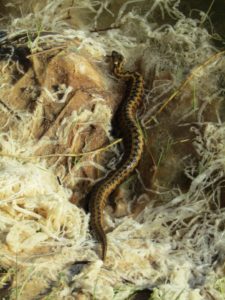
This adult Natrix maura is putting on a good show! Not a bad Viper imitation in my opinion.
The Iberian Grass Snake (Natrix astreptophora)
Further up the bank from where I was observing Natrix maura I found an Iberian Grass Snake. Usually a Grass Snake isn’t something too out of the ordinary (I see a lot in my area), but the Iberian Grass Snake is particularly interesting due to its recent elevation to species level.
The identification of Natrix astreptophora as a distinct species was made by Pokrant et al. (2016), in an altogether flawless study published in the Biological Journal of the Linnean Society. Before this study, the Iberian Grass Snake was known as Natrix natrix astreptophora – a subspecies of the Common Grass Snake (Natrix natrix) that replaced another subspecies, Natrix natrix helvetica in the Iberian Peninsular and northwest Maghreb.
The reason this is interesting is because the study by Pokrant et al. is a fantastic example of the correct way to identify a cryptic species that would otherwise have remained incorrectly classified as a subspecies. In effect, they used external morphology (meristic traits such as scale counts), skeletal morphology and genetic analysis to determine the following:
When compared to N. natrix and N. n. helvetica, Natrix astreptophora has –
- a lower number of ventral scales and a different iris colour (red)
- differences in mitochondrial DNA, vertebrae morphology and skull morphology
The authors also used the analysis of microsatellite loci and two mitochondrial markers to demonstrate that N. astreptophora hybridised very little with N. natrix helvetica, that it encounters in the east of its range.
In 2017, Natrix n. helvetica was also elevated to species level, in a separate study, and is now Natrix helvetica.
If you have an interest in taxonomy then this is the kind of paper you need to read. Remember, an in-depth study is always more informative than the watered-down articles in the press, with headlines like “scientists discover new species of Grass Snake”! The title of the publication by Pokrant et al. was “Interpretive taxonomy provides evidence for the species status of the Ibero-Maghrebian grass snake Natrix astreptophora“, and it can be accessed for free online.

This snakes camouflage was perfect for its location. Notice the red iris, a defining characteristic of the species.
What else is there to see in the Algarve?
First of all, there’s a few other amazing reptile species that I encountered but haven’t discussed here, like the ones in the photos below. Click on a photo to see it enlarged. Also, there are a fair few amphibian species present, notable examples being the Spanish Ribbed Newt (Pleurodeles waltl) and the Mediterranean Tree Frog (Hyla meridionalis). Though I didn’t go looking for amphibians on this trip, they can be found here during the cooler months by surveying temporary pools, ponds and streams at night, or in the warmer months by flipping stones near them.
Marine life, invertebrates and birds
A part from herps, the Mediterranean basin is a hot spot for plant diversity, invertebrate diversity, bird life and marine biodiversity. So if you aren’t finding the reptiles and amphibians you want to see, then shaking bushes to collect bugs or walking along a beach at low tide can almost make up for it.
Believe it or not, this European country is home to decent sized scorpions, a Solifugid and at least one species of tarantula (Ischnocolus sp.), despite being just a two hour flight from rainy England. As for the marine life, you can easily find sea cucumbers, a variety of crab species and giant sea slugs such as the one in the clip below, known as a Sea Hare (Aplysia sp.).
Human impact on the Algarve fauna and flora
As I said before, there are protected areas throughout the Algarve, but pressure from tourism is constant. Many once-wild areas are now hotel complexes and golf courses where dead on road snakes are a common sight. There are conservationists doing their best to help the local wildlife, however.
In the Ria Formosa Natural Park, for example, they run a wildlife rehabilitation centre called the RIAS Centre (or the “animal hospital” by staff) on a tiny budget, but still manage to help up to a thousand animals each year. For a time, they also reared and released turtles to help increase their survival rates. Unfortunately their funding was pulled for this project a couple of years ago. If you do find yourself in the Ria Formosa Natural Park, a good idea would be to pop into the RIAS Centre and offer a donation; even €3 or €4 is appreciated. You can also fin their website here: Ria Formosa Nature Park
Herping can harm the environment if done without due care!
A few years ago, I went to the Ria Formosa area but found a lot of logs ripped apart and rocks left overturned, almost undoubtedly by other herpers. If left overturned, a hiding place no longer offers the same protection from the elements, and this ruins a microhabitat that some animals rely on. Over several years, this type of disturbance affects local animals’ behaviour and therefore their reproduction and survival rates. There’s no reason herping can’t be done without causing harm, it just takes a few extra seconds to put a rock back in exactly the same place.
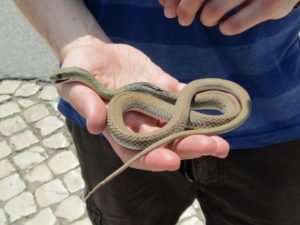
Dead on road snakes are all too common in the Algarve. This photo is a Montpellier Snake (Malpolon monspessulanus), a species I was sorely disappointed not to find alive.
Herping Portugal. How does it stack up?
As far as European herping goes, the Algarve is your best option asides from Greece and Cyprus. Whilst you may not find a fantastic range of species, the ones that you will find tend to be highly specialised, with thought-provoking natural history and taxonomy. Another good point for the region is that there is a rail line, with regular stops, going all the way from the border with Spain to Lagos – making travelling easy if you don’t rent a car.
As with any climate and habitat type, the Mediterranean region’s climate is replicated at similar latitudes around the world. In Chile, South Africa, California and Australia there are Mediterranean type regions, whose fauna and flora share convergences with their European counterparts. The Algarve is a great place to go herping, but the best educational experience would be to also visit one of the other Mediterranean climate zones to see the aforementioned convergences for yourself.
As a herping destination, I would rate the Algarve as follows:
- Species richness 4/10
- Herp population density 6/10
- Peripheral and endemic species 6/10
- Safety, food and ease of travel 9/10
To find out more about the author, go to Who am I?

